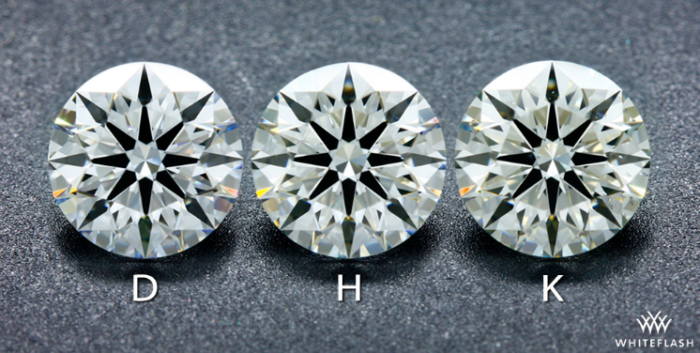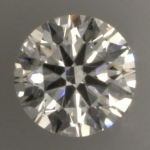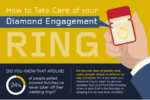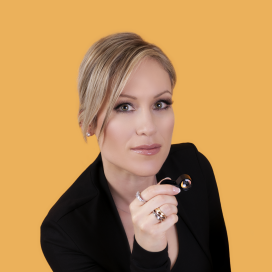A diamond’s color is an easy concept to grasp. When diamonds are formed naturally, they consist of carbon and other naturally occurring minerals. A diamond that is composed of 100% pure carbon without any impurities would be considered a completely colorless diamond.
Most diamonds, however, do have some color due to the traces of nitrogen, boron, hydrogen and other elements. Nitrogen is the predominant element most commonly found in diamonds. The carbon-nitrogen composition creates diamonds with pale yellowish to brownish tints. Therefore, diamond color refers to a diamond’s transparency, or lack of color (lack of yellowish/brownish tints). Diamond color grades are often over exaggerated when actual visual difference in color is very difficult to detect.
Most jewelers or laboratories grade ‘whiteness’ or colorlessness using the Gemological Institute of America’s (GIA) professional color scale. This is considered to be the industry standard for diamond color grading today. However, years before the GIA developed their universal diamond color grading standard, there existed other scales by which to grade a diamond’s color. In an effort to differentiate themselves from these other international sources, they started their scale with “D” and ended it with “Z”. A “D” colored diamond is considered colorless or translucent and also the most rare. As the alphabet progresses, the diamonds are rated with stronger yellower and brownish hues.
A trained gemologist examines each diamond face-down under carefully controlled lighting. A “master stone” is then used as a color comparison to gauge which color grade a given diamond falls into. Master stone’s have a predetermined color and thus serve to ensure that each diamond color is graded consistently.
Diamonds graded D through F are referred to as “colorless” while diamonds graded G through J are considered “near-colorless”. A truly colorless stone, graded D, are very valuable and extremely rare. The closer a diamond is to being colorless, the rarer and more valuable it is. Near-colorless diamonds will be less expensive. However, it is important to point out that the difference in appearance between “colorless” diamonds and “near-colorless” diamonds often times isn’t easily detectible by the untrained eye. The pricing difference for these stones, however is significant.
Diamond Color Grades:

Diamond color chart courtesy of Whiteflash.com
- D Colored Diamonds – Are 100% colorless. This color grade represents the highest color grade and represents only the most extremely rare and most expensive diamonds.
- E-F Colored Diamonds – Are exceptionally transparent. Only a trained gemmologist can detect color differences between D, E, and F colored diamonds when compared side by side; and very rarely by the untrained eye. These diamonds are still very rare and quite costly.
- G-H Colored Diamonds – Are nearly colorless. Only when compared to a master stone of a higher color grade is the tinting of these diamonds apparent. Otherwise, their color is nearly imperceptible to the naked eye. Rare but less expensive.
- I-J Colored Diamonds – Are nearly colorless but with a slightly more visible color tint. Once again, color tint is imperceptible to the naked eye when viewing the diamond in a mounted setting. These stones are more common and offer a extraordinary value; can be found for half the price of a D colored diamond.
- K-M Colored Diamonds – Have a color tint that is more perceptible to the naked eye. However in terms of pricing, these stones are usually half the price of a G colored diamond.
- N-Z Colored Diamonds – Have a very light or light yellow noticeable color. Not typically sold as gemstones however they can be used in jewelry for a significant price reduction.
Diamond Color Is Considered A Rarity Characteristic
The whiter or more pure a diamond (no trace elements in it’s carbon atomic structure), the more rare it is. It’s important to distinguish the word ‘rarity’ vs. ‘beauty’. A ‘D’ colored diamond is indeed rare, however a ‘D’ colored diamond isn’t necessarily beautiful. Remember what I mentioned about cut grades? For example, a ‘D’ colored diamond that is cut with a steep crown angle and a deep pavilion angle will carry extra carat weight in the pavilion and thus appear smaller face-up for it’s carat weight. It will also leak light through the pavilion resulting in a dark, dead looking stone; this despite the fact that it is a rare ‘D’ color.
Therefore, cut is of utmost importance as this directly relates to brilliance and sparkle. I’ve seen plenty of gorgeous ideal cut ‘K’ or ‘L’ colored diamonds. Also, if you are searching for a round brilliant diamond you will have more flexibility with regards to color grade. This is because the brilliance (or light reflection) is maximized in the round shape as it is perfectly symmetrical. The increased brilliance makes it more difficult to detect a faint color tint in the stone. In this case, any diamond over the color grade “I” will appear completely colorless to the untrained eye (however, if compared to diamonds that are at least 3 color grades above it, you may notice the difference).
Just remember beauty is not related to color grade. You can still have a very beautiful brilliant diamond that is not colorless. The truth is that most people haven’t dealt with diamonds to any great length, and because of this they realistically wouldn’t know the difference between a “D” colored diamond vs. a “J” colored diamond when viewed separately. Given this fact, as well as the pricing increase, if you were to purchase a colorless diamond (D, E, or F) it would be a value that you couldn’t visually appreciate.

Diamond color comparison from crown view. These diamonds are all A Cut Above diamonds from Whiteflash and show no obvious color saturation due to their high precision cut and maximized white light reflection. This is something to consider for a consumer looking to cut costs and maximize carat weight.
In addition to not being able to tell a visual difference of color, there is also the issue of diamond pricing. For diamonds that fall within the G-J color range, the price tends to increase 10-20% between each diamond grade. For the price of a colorless diamond (D), you could find a suitable alternative in a I-J color for HALF the price. Likewise, a K-M colored stone normally runs you HALF the cost of a G colored diamond.
If you are looking for the best and biggest diamond for your budget, then it is worth considering going a couple of color grades lower to save on the potential hundreds or thousands of dollars difference in pricing. For example, with the savings made from choosing a lower color grade, one could choose a larger diamond. Combine this with an ideal cut and you get maximum sparkle and carat weight while saving money.
When I developed The Diamond Genie, I wanted to make the personalized recommendations relevant to an individuals metal setting color (white gold/platinum, yellow gold or rose gold). So, if you were looking for a round brilliant diamond but were going to set it in a yellow gold setting, you could save cash by searching for diamonds that are ‘I’ color or lower. In the end, it’s really about what makes you happy and what makes you feel comfortable but I’ve learned that most consumers are looking to get the largest most sparkly diamond for their budget and I have certainly tried to make that an easier process for them. 🙂
ODBA Recommends
You May Also Like








